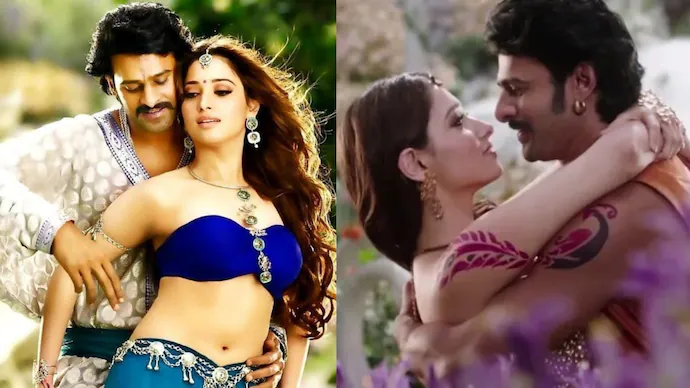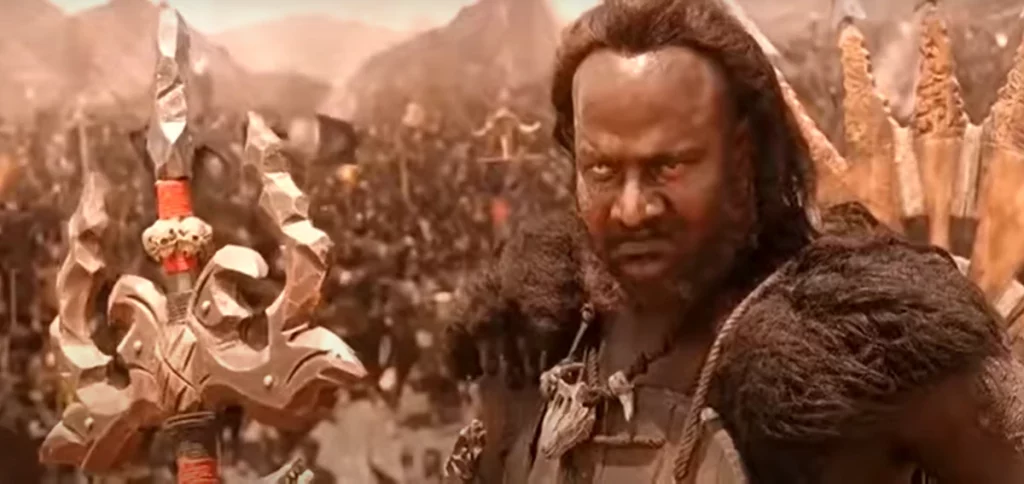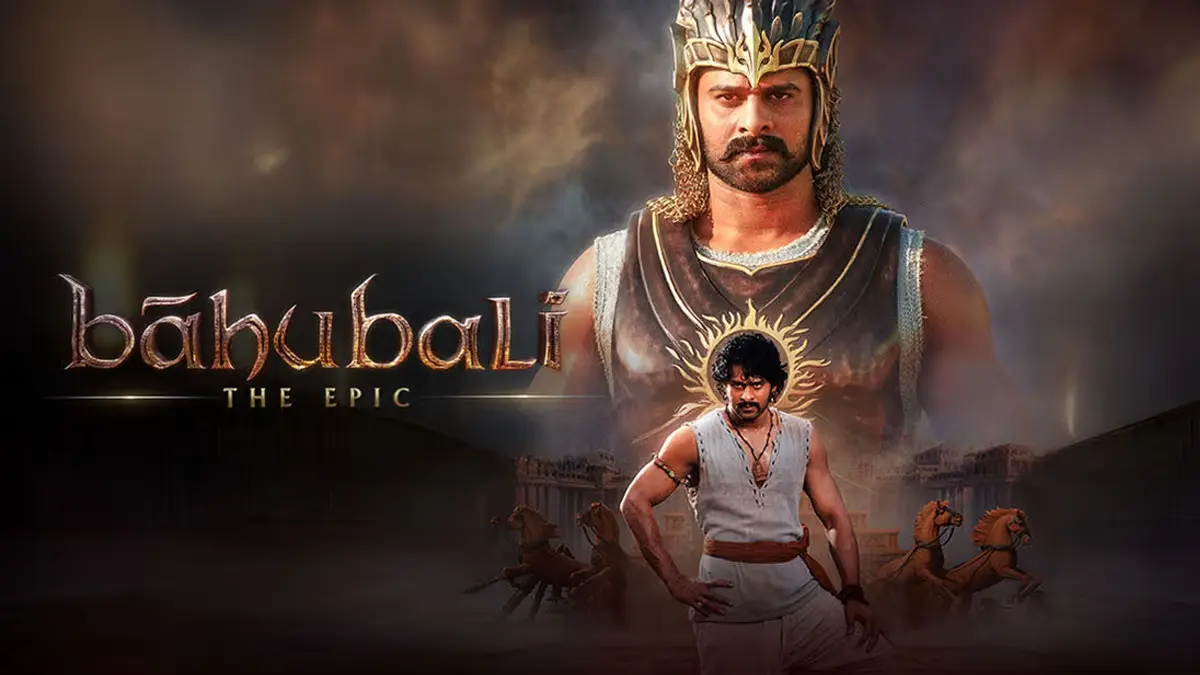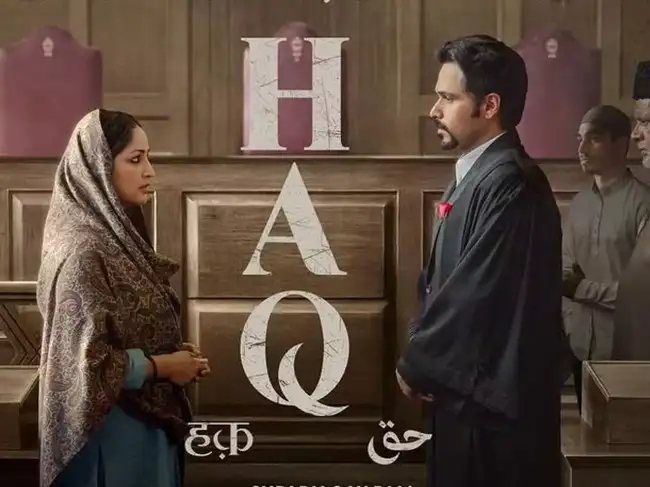Baahubali: The Epic hit theatres this week. The film is a recut of Baahubali: The Beginning (2015) and Baahubali: The Conclusion (2017) into a single 3-hour 45-minute film. Starring Prabhas, Anushka Shetty, Ramya Krishnan, Nasser, Rana Daggubati, Sathyaraj, and Tamannah Bhatia in lead roles, the film tells the tale of Mahendra Baahubali alias Shivudu (Prabhas), who, unbeknownst to him, is the prince of the kingdom of Mahishmati. Through flashbacks, we are told the tale of Shivudu’s birth parents, Amarendra Baahubali (played by Prabhas in a dual role) and Devasena (Shetty), and the circumstances surrounding his birth.
While both Baahubali films have garnered praise for their cinematography and acting, they have some insidious issues, especially regarding their portrayal of women and marginalised characters. Baahubali: The Epic removes some of the more misogynistic parts of the original films, but the film’s misogyny problem, interest in appealing only to the male gaze, and highly offensive and stereotypical depictions of tribals are still present, making the new film a wasted opportunity to get rid of some of the worst parts of the original films.
The film loudly and unabashedly caters to the male gaze. The women in Baahubali aren’t the only ones written and shot in ways to satiate the male gaze; the entire enterprise is aimed at that. Shots of Prabhas’ biceps, Daggubati’s toned back, or the fact that these characters keep taking their shirts off might seem like a way to make them appealing to women; however, this isn’t the case. These shots exist, not to sexualise Prabhas or Daggubati for women, but to fetishise them for the male gaze. Prabhas’ masculinity is not portrayed as attractive but aspirational – for other men.
Pushing the envelope, but not enough
A cursory view of Baahubali might lead one to believe that the film has strong female characters. Anushka Shetty’s Devasena is a headstrong, opinionated, and vocal woman who always stands up for herself; Ramya Krishnan’s Shivagami is the fiery matriarch of the household, whose word is law; and Tamannah Bhatia’s Avanthika is a courageous and dedicated warrior.
However, the film is only willing to push the envelope so far and only so long as it doesn’t interfere with the benevolent hero act. Avanthika is a skilled warrior who has dedicated her life to freeing Devasena from Bhalladeva’s (Daggubati) prison. Yet, it’s the man, Shivudu, who steps in and ultimately frees her, sidelining Avanthika in the mission she dedicated her entire life to. Avanthika is also a skilled fighter, but still requires saving. A trained warrior’s ability to fight pales in comparison to that of the hero, who has received no training and whose only skill seems to be his physical strength.

Devasena is also a skilled warrior, but when it comes time for a confrontation, Amarendra still has to step in to help her. While these women might not be damsels in distress, the film reminds you that they are no heroes either. Shivagami (Krishnan) is portrayed as the strongest woman of all. She’s Bhalladeva’s biological mother and Amarendra’s adoptive parent. The film begins with her fighting armed men to save an infant Shivadu. Injured and with an arrow in her back, she braves a rough river to save the life of her grandson.
However, while Shivagami might be strong, she’s still a patriarchal character. In an especially problematic scene, Bhalladeva tells Shivagami that he ‘wants’ Devasena. A courtier standing nearby points out the absurdity of ‘wanting’ a woman like she’s an object he can possess. This dialogue gives viewers hope that the film will make a feminist point; however, that hope is killed within seconds. Shivagami retorts by asking why her son can’t ‘get’ Devasena and promises to fulfil this ‘small’ desire. Bhalladeva is the film’s villain; it can be argued that his misogyny is not glorified. However, having Shivagami reiterate the point only affords it legitimacy and makes it more palatable.
The Rape of Avanthika and off-screen misogyny
In 2015, famed film critic Anna MM Vetticad wrote a piece titled ‘The Rape of Avanthika‘ in the Hindu Business Line. In the article, Vetticad questions a problematic scene in Baahubali: The Beginning in which Shivudu tattoos Avanthika (Bhatia) without her consent, in an effort to ‘feminise’ her appearance. He then proceeds to disrobe her, altering her attire to something more feminine, unties her hair, and applies a red tint to her lips.
The scene ends with Avanthika looking into a waterfall and realising how beautiful she is. The scene, start to finish, depicts sexual harassment, but it’s performed as a romantic dance sequence. In fact, the film would have you believe that it is not only romantic but a benevolent gesture not to allow a woman’s beauty to go ‘wasted’.
Vetticad rightly pointed out how troubling the scene was. While some agreed with her, she was also subjected to threats, harassment, and relentless attacks for her article. After she reviewed the second instalment, Vetticad received further harassment and trolling of a misogynistic and communal nature. The second part of the film was curiously labelled a ‘Hindu film’ by the online right-wing ecosystem, and her valid criticisms of it were unjustly called communally motivated.

Although it has been a decade since the original Baahubali film was released and Vetticad wrote her article, during a recent appearance on Lallantop, Tamannah Bhatia was asked to comment on it. Bhatia, refusing to see the merit of the piece, instead attacked Vetticad, implying that such articles are a result of how sex repressed Indian society is and how people resort to such critiques when they cannot ‘control’ women. It must be noted that Vetticad’s original piece discussed the character of Avanthika and her treatment in the film; nowhere does it mention Bhatia, the actor.
Bhatia conflating sexual harassment with sex is perturbing to say the least. In the rejoinder Vetticad put out after Bhatia’s comments, she said, “That scene in Baahubali showed a woman initially enraged at the repeated violation of her bodily integrity by a man, but eventually making love to him. It is dangerous because it echoes what our society tells boys and men: that when a woman says no, she means maybe or yes; that true love or genuine attraction means persisting even after she rejects your advances; and that it is up to a man to ‘make her realise’ (to quote an oft-used phrase) how beautiful she is.“
The Rape of Avanthika asked pertinent questions about misogyny, rape culture, and the romanticisation of sexual harassment in cinema. By falsely characterising it as an attempt at moral policing, Bhatia does a great disservice. Criticism of films is often brushed off with ‘it’s just a film’ or ‘don’t watch it’, but it’s disingenuous not to admit that cinema and society have a symbiotic relationship. Our films will contain themes normalised in society, and society will adopt the messaging normalised in cinema. Glorifying sexual harassment as ‘romantic’ and lending credence to the idea that women must perform femininity as dictated by the patriarchy, then, deserves to be called out.
The curious case of performing femininity in Baahubali
The bulk of the original scene referenced in The Rape of Avanthika has been cut in Baahubali: The Epic. However, the film retains the very last scene and adds narration that says Shivudu finally showed Avanthika her beauty. While the sexual harassment dance (quite literally a dance) was cut, the misogynistic and patriarchal idea that women ‘must’ perform femininity in ways that titillate men was still retained.
Contrasting the characters of Avanthika and Devasena is especially useful in this regard. Both are strong women, but Devasena is closer to traditional ideas of femininity. While fierce, Devasena still outwardly presents in feminine ways, especially in how she dresses. Vocal, confrontational Devasena, trained in combat, is palatable as she is because she’s at least feminine in appearance, but Avanthika needs to titillate to be acceptable.

The film’s strong female characters are only allowed to be ‘strong’ so long as they still perform femininity. Baahubali is full of scenes of men fighting and pulling off extraordinary feats of strength. Cameras zoom in on their muscular build to portray this strength. However, when it comes to Devasena, the camera zooms in on her eyes and lips during a combat scene. Devasena is a skilled warrior, that’s important to note, but that’s secondary to her beauty, which is the most important thing about her.
Blackface, tribals, and bigotry
The film also indulges in blackface, the highly racist practice of painting the faces of non-black actors to imitate a Black person. In the Indian context, this is sometimes known as brownface, where fair-skinned actors wear painted faces when portraying marginalised characters. The scene in which Mahishmati is at war with the Kalakeya tribe features actors with blackened faces.
The stereotypical and highly offensive portrayal of tribals doesn’t end there, either. The clan leader and his soldiers are all extremely unkempt, with rotting teeth, and are wearing animal hides. And they speak gibberish. Kilikili was a language created for the movie’s tribe and was intentionally designed to sound primitive. The film also leans heavily into the idea that tribals and indigenous people are ‘savages’. The Kalakeya side has animal bones strewn around to drive this point home, in case you missed it. On the other hand, our savarna hero refuses to uphold the tradition of animal sacrifice because of his progressive ethos.

If the film didn’t want to put in the effort to portray tribal characters with nuance, then it could just as easily have portrayed the adversary as any other kingdom. Our Kshatriya heroes, whose caste the film mentions a few times, are fair-skinned, progressive, and cultured. Their victory over the othered ‘barbarians’ raises the stakes and the entertainment value. And the decision to portray them as barbarians is by design. Madhan Karky, who developed Kilikili for the film, told NDTV in 2015, “Rajamouli didn’t want to categorise the Kalakeyas into any clan or ethnicity, but wanted to project them as barbaric brutes, who invoke endless fear.” As long as bigoted, stereotypical portrayals of the marginalised to make the savarna hero look good find an audience, they will continue to dominate our films.
What the film gets right
When Devasena rejects Bhalladeva’s proposal to become his wife, Shivagami is enraged. So much so that she wants Devasena to be brought to her court as a prisoner; this is perhaps the one place where the film does justice to its women. Devasena is enraged at this, and Amarendra, instead of playing the dutiful son of Indian cinema, stands up to his mother.
Throughout the film, Devasena also stands up to Shivagami for what she perceives as the latter’s unjust and unreasonable decisions. Amarendra never attempts to silence her by prioritising respect for elders and authority over his partner’s autonomy and well-being. Devasena is not the quiet, pious, self-sacrificing wife; she is loud and vocal in her rage, and neither the film nor Amarendra castigates her for it.
However, that isn’t enough to redeem the film. Baahubali: The Epic was an opportunity to rewrite some of the critical errors of the previous two films and address serious issues regarding misogyny, the patriarchal gaze, and bigotry; yet the makers seem to be interested in no such thing. The film is visually breathtaking, with a meticulously crafted score, and features some incredible performances; however, it succumbs to the valid criticisms levied against Telugu cinema for a long time now.
While Devasena’s character is a delight, the film’s portrayal of its women is not progressive in any substantial way. These characters can be strong but only if they still perform femininity for the patriarchal gaze. They can be skilled warriors, but only as long as they give way for the hero to demonstrate his heroism. They can be self-willed women, but only so far as it doesn’t hurt patriarchal sensibilities.
About the author(s)




